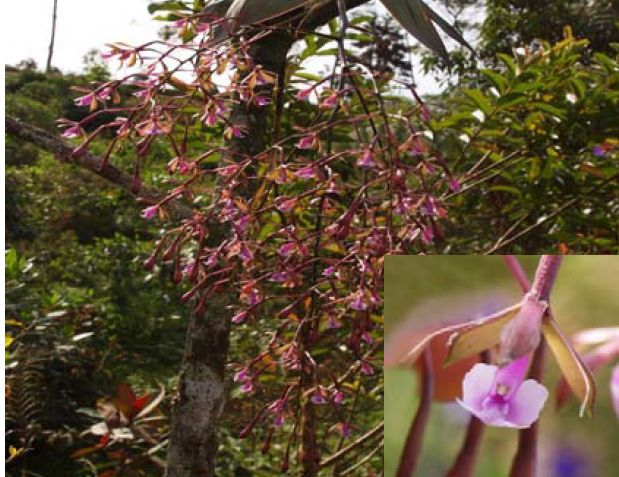

Epidendrum giraldo-canasii Hágsater, O.Pérez & E.Santiago 2013 GROUP Pseudepidendrum SUBGROUP Porphyreum
TYPE Photo/TYPE Drawing by © Perez and The AMO Herbaria Website



 MID
MID  MID
MID 
Common Name Dr. Giraldo Cańa's Epidendrum [Colombian Botanist and professor at the Universidad Nacional de Colombia in Bogota current]
Flower Size 1.2" [3 cm]
Found in the department of Valle de Cauca department of Colombia on the eastern slope of the Cordillera Occidental at elevations around 2000 meters as a large to giant sized, cool to cold growing epiphyte with cane-like, simple, terete, straight, ascending stems carrying 11, held in the apical 2/3's of the stems alternate, articulate, unequal in size, basally smaller, elliptic, acuminate, coriaceous, the upper face green, the underside purple, margin entire leaves that blooms in the mid winter through mid spring on a terminal, without a spathe, paniculate, occuring only once, peduncle to 2.4" [6 cm] long, straight, thin, enveloped completely by a single, tubular, acuminate, amplexicaul bract, rachis to 13.6" [34 cm] long, terete, gradually thinner towards the apex, to 8 branched, each branch few flowered, 4.4 to 6" [11 to 15 cm] long, each branch with a linear-triangular, long-acuminate, amplexicaul bract, arched nutant, to 16" [40 cm] long overall, laxly, mostly simultaneously to 100 flowered inflorescence with much shorter than the ovary, narrowly triangular, acuminate, amplexicaul floral bracts and carrying resupinate, delicately fragrant flowers with the sepals dorsally magenta, internally ochraceus, petals and lip light pink, column magenta, somewhat yellowish at the base.
"Epidendrum giraldo-canasii belongs to the GROUP Pseudepidendrum , which is characterized by caespitose plants, cane-like stems, acute to acuminate leaves, apical inflorescence without spathaceous bract, the petals filiform and the lip usually 3-lobed, with 3 parallel fleshy ribs, the apical lobe often bifurcate, and the pollinia “bird-wing type” and SUBGROUP Porphyreum which has flowers colored reddish orange, deep purple or lilac-pink, the calli generally prominent, sometimes horn-like. The species is recognized by the intense purple color of the lower surface of the leaves, stems stained with purple, the prominent calli of the lip elongated until the base of the mid-lobe, lateral lobes of the lip dolabriform, .12 x .2" [3 x 5 mm], and by the hastate, linear lobes of the mid-lobe, strongly divaricated, as long as the lateral lobes. It is similar to Epidendrum peraltum, which has larger plants, green, concolor leaves, and somewhat larger yellowish-green, un-fragrant flowers tinged with pink or totally dirty pink, lateral lobes of the lip falcate-oblong, strongly retrorse, and the mid-lobe with a short isthmus, ended in a pair of lobes strongly divaricated shorter than the lateral lobes. Epidendrum capricornu Kraenzl. endemic to Peru and Ecuador, has shorter plants, sepals with the outer surface purple brown, the inner surface yellow, slightly wider between the lateral lobes of the lip than between the apical lobes, and the mid-lobe strongly emarginate, forming a pair of linear-horn-like lobes, slightly divaricate." Hagsater etal 2013
Synonyms
References W3 Tropicos, Kew Monocot list , IPNI ; * Icones Orchidacearum 14 Plate 1432 E. Hágsater, O. Pérez & E. Santiago 2013 photo/drawing fide; Orchids of the Department of Valle De Cauca Colombia Vol 2 Kolanowska, Hagsater etal. 2014 drawing fide; Orquideas, Tesoro de Colombia Vol 2 Ortiz & Uribe 2017 photo fide
--------------------------------------------------------------------------------------------------------------------------
--------------------------------------------------------------------------------